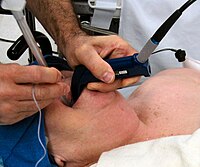
Photo from wikipedia
Awake fibreoptic intubation (AFOI) remains the gold standard technique for securing difficult airways of patients. However, stimulation of the airway structures in an awake patient leads to undesirable autonomic stimulation,… Click to show full abstract
Awake fibreoptic intubation (AFOI) remains the gold standard technique for securing difficult airways of patients. However, stimulation of the airway structures in an awake patient leads to undesirable autonomic stimulation, and therefore, adequate patient preparation is necessary to ensure the ease and success of any awake intubation procedure. Sedation of a patient with a truly difficult airway is fraught with dangers of oversedation and airway obstruction. Hence, topicalisation of the airway with local anaesthetics remains the mainstay of the success of any awake intubation technique. However, local anaesthesia (LA) of the airway itself may lead to complications such as upper airway obstruction, aspiration of gastric contents or LA toxicity. The literature is flooded with different techniques of topicalisation of the airway, and many extensive reviews are available on the same (14). Every anaesthesiologist frequently performing AFOI has developed his own technique. The multitude of techniques available are often confusing to beginners or anaesthesiologists who perform AFOI only occasionally, and it is important to identify an easy and effective method of applying local anaesthetics to the airway.
Journal Title: Turkish journal of anaesthesiology and reanimation
Year Published: 2018
Link to full text (if available)
Share on Social Media: Sign Up to like & get
recommendations!